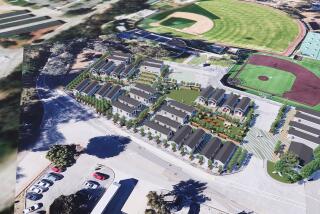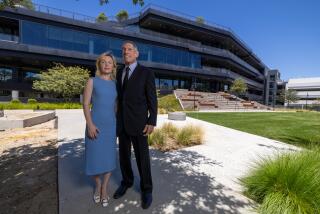A seamless move for hospital
UCLA Medical Center’s new hospital admitted its first patients Sunday after successfully moving patients across the street from its old facility in a delicate, tightly scheduled operation.
The transfer occurred even as new mothers delivered their babies and doctors performed organ transplants. The 335 patients were moved at the rate of one every two minutes.
The move capped years of planning that began after the 1994 Northridge earthquake badly damaged the old site.
“I found it a very emotional experience to actually see the patients moved,” said Gerald S. Levey, dean of the David Geffen School of Medicine, adding that some staffers wept. “It’s wonderful to finally see the new hospital filled with people.”
Some of the most acutely ill patients were transferred in mobile intensive-care units. About 2,100 staffers and 30 ambulances participated. Traffic on Westwood Boulevard was stopped during the transfer, which began at 5 a.m. and ended at noon.
“It’s just like going into a big sporting event,” Levey said. “You think you are prepared, but you never know.”
The facility opened after significant delays, with its cost growing from $597.7 million to $829.3 million. The building has been praised for its humane environment.
The design by I.M. Pei and his son, C.C. “Didi” Pei, “is not one of Pei’s greatest works,” former Times architecture critic Nicolai Ouroussoff said, but given its constraints, “the project is a masterful piece of light, nature, and scale -- one where architecture can function as an integral tool in the healing of the human psyche.”
Officials have said it should be able to withstand an 8.0 magnitude earthquake.
The complex is home to the Ronald Reagan Medical Center, the Mattel Children’s Hospital and the Resnick Neuropsychiatric Hospital. It replaces a labyrinth-like complex that has 3.1 million square feet and 27 miles of corridors.
“We’ve built a hospital that is for the patients and for their families,” Levey said. “We wanted to emphasize light and spaciousness.”
Patient rooms at the new hospital are singles; the old site had many doubles.
“It’s really, really nice,” said Lisa Beck, who was lying in a chair next to her 11-year-old daughter, Miranda, a patient at the new hospital. “The rooms are really nice, just spacious . . . I love the windows.”
Miranda was moved to the new structure shortly after 7 a.m. Her mother said the transition was seamless and on time. When she walked into the new children’s ward, Miranda said, her first reaction was: “Wow.”
“They have a lot of games,” Miranda said, her attention drifting to a flat-screen television next to her bed that was playing the movie “Enchanted.” “When you step into it, you can look up at the ceiling and the constellations are in blue.”
The ceiling Miranda described was in the rotunda entrance to the children’s playrooms. The new hospital has a terrace for young patients to play on and small electric cars for them to ride. The first game played was on a Nintendo Wii video game system.
Two floors down, 36-year-old Wally Wu was awaiting a heart transplant. He said the hospital was especially nice for his wife, who often stays with him in the room.
“It pulls out to a double,” Wu said of a daybed next to his room’s window.
Other amenities include hotel-style room service, with meals carried to each room by waiters wearing bow ties. Hospital directors also said they had state-of-the-art medical technology, including top-notch imaging machines.
At midafternoon Sunday, the hospital’s first baby arrived. Weighing in at 6 pounds, 8 ounces, Antonio Ronald Morales was born at 2:28 p.m. to Antonio and Nancy Morales of Los Angeles.
Levey said the Peis had designed the hospital to last 100 years. “With any luck, it will support us for even another century after that,” he said.
--
--
More to Read
Sign up for Essential California
The most important California stories and recommendations in your inbox every morning.
You may occasionally receive promotional content from the Los Angeles Times.











